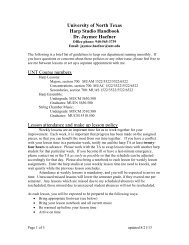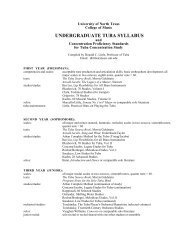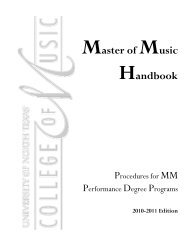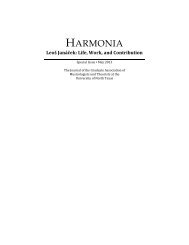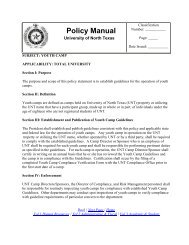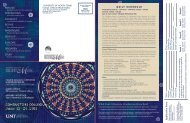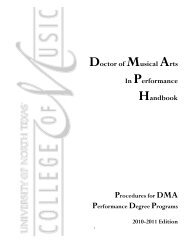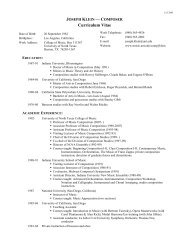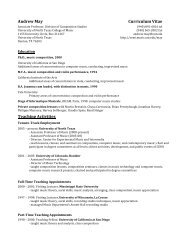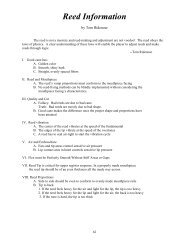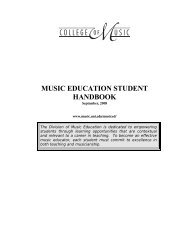University of North Texas - UNT College of Music - University of ...
University of North Texas - UNT College of Music - University of ...
University of North Texas - UNT College of Music - University of ...
Create successful ePaper yourself
Turn your PDF publications into a flip-book with our unique Google optimized e-Paper software.
A Guideline for Student Teaching Observations<br />
The following guide suggests areas <strong>of</strong> consideration for observation <strong>of</strong> student teaching. While each teaching event will<br />
be particular, and no guide can predict in advance the most salient aspects <strong>of</strong> a lesson in which to attend, the suggested<br />
areas below can serve to organize the observational process. Experienced observers may wish to utilize the guide as a<br />
check against observer notes.<br />
I. Teaching<br />
A. Planning and Organization<br />
1. Knowledge <strong>of</strong> all music and instructional materials used in the classroom<br />
2. Demonstrates sufficient depth and breadth <strong>of</strong> subject area knowledge<br />
3. Evidence <strong>of</strong> planning through written lesson plan<br />
4. Planning reflects consideration <strong>of</strong> individual lesson as contribution to longer range goals<br />
5. Prepares appropriate instructional goals and objectives<br />
6. Devises teaching strategies to realize instructional goals and objectives<br />
7. Uses terms, materials, repertoire, and activities suitable for the age level, abilities, and<br />
particular needs <strong>of</strong> the students<br />
8. Provides for a variety <strong>of</strong> activities<br />
9. Organizes activities into meaningful structure, including summarizing activities to evaluate<br />
whether learning has occurred<br />
10. Assures that facilities, supplies, equipment, instruments, or other needs to carry out instruction<br />
are available and accessible to students<br />
B. Instruction: General Skills<br />
1. Communicates to students goals for the lesson<br />
2. Gives directions clearly<br />
3. Maintains visual contact with students<br />
4. Uses a variety <strong>of</strong> teaching strategies<br />
5. Balances nonverbal and verbal activities to best engage student<br />
learner<br />
6. Evidences ability to improvise in action, adapting the preplan to respond to actual classroom<br />
events<br />
7. Reflects on teaching actions and/or classroom events to check<br />
for student understanding<br />
8. Demonstrates inclusion <strong>of</strong> student contributions in the learning<br />
process<br />
9. Involves students in self-reflection and evaluation <strong>of</strong> learning<br />
10. Pacing is suited to maintain student involvement<br />
11. Opportunities for student success and reinforcement occur throughout the lesson<br />
C. Instruction: <strong>Music</strong>al Skills<br />
1. Provides musical model for students to emulate<br />
2. Conducting reflects musical understanding and is technically skilled<br />
3. Demonstrates competency on keyboard, classroom, or<br />
secondary instruments<br />
4. Demonstrates effective teaching pedagogy in major field (voice, winds, percussion, etc.)<br />
5. Demonstrates skill in the use <strong>of</strong> singing voice<br />
D. Classroom Management<br />
8




